In Brief
Booting up global connections
Medicines without borders
Calculating the odds in a worst-case scenario
Containing emerging biologic threats
Improving performances
On call for the community
Childhood pneumococcal vaccine saves lives
Huda C. Zurayk gives Virginia S. DeHaan Lecture
Preparing for public health emergencies
Association of Black Public Health Students
Paying the price of smoking
Intensive care - Julie Gazmararian
Cyber text - David Kleinbaum and ActivEpi
|
Booting up global connections
A new international fellowship
program has been established at the Rollins School of Public Health (RSPH) in honor of William Foege, the
Presidential Distinguished Professor of International Health and senior adviser to the Bill & Melinda Gates
Foundation. The William H. Foege Fellowships in Global Health will bring four Foege fellows from developing
countries to study at RSPH each year, beginning in the fall of 2003. |
|
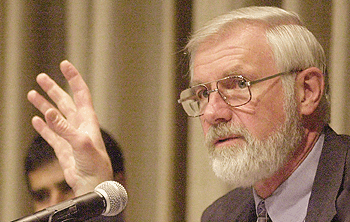
|
The fellows will be mid-career professionals who will work with mentors at public health agencies in Atlanta,
including Emory, the Centers for Disease Control and Prevention (CDC), The Carter Center, and CARE. Fellows will
receive a laptop computer when they begin the program, and they will be encouraged to take it with them when they
leave. The goal is to help public health leaders in the developing world plug into the global network of
knowledge and expertise and stay connected.
The Gates Foundation gave the RSPH a $5 million endowment gift to establish the program in Foege's honor.
“Bill Foege has devoted his life to ensuring that others can enjoy full and healthy lives,” says Bill Gates,
Sr.
“I can think of no better way to honor him than to encourage and train others to continue
the work he pioneered.”
Foege was one of the masterminds behind the smallpox eradication campaign and has served as director of the CDC,
executive director of The Carter Center, a member of the CARE board, and a faculty member at RSPH.
In addition, the O.C. Hubert Charitable Trust has granted RSPH $1.4 million to establish the William H. Foege
Chair in Global Health. An Emory commitment brings the total endowment for that chair to $2 million. The
recipient of the chair will direct the Foege fellowship program as well as the O.C. Hubert Fellowships in
International Health, which help support international field research experiences for students each year.
Medicines without borders
Every day in the developing world, people die deaths that could have been prevented by appropriate medicines. But
in some of the world’s poorest countries, essential medicines are too expensive or are no longer produced by drug
companies. Available drugs are often ineffective or highly toxic. Doctors Without Borders has launched the Access
to Essential Medicines Campaign to heighten awareness of this problem. The Rollins School of Public Health helped
bring the traveling exhibit to the Emory campus during Human Rights Week this past April, and Dean James Curran
toured the exhibit along with several RSPH faculty members.
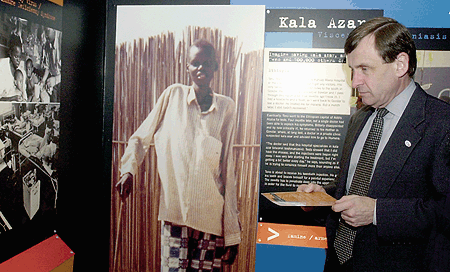
Calculating the odds in a worst-case scenario
If a suicidal
terrorist with contagious smallpox were to amble down a crowded city street, run through a residential
neighborhood, or pass through the busiest airport in the world, random chance would have much to do with how many
others that person might infect and how many new infections they, in turn, would pass on, and so on down the
line.
The National Institutes of Health contracted with biostatisticians at the Rollins School of Public Health (RSPH)
to statistically model the potential spread of smallpox if it were unleashed in the United States. Their
findings, published in the November 15 issue of Science, should help government officials plan
immunization
strategies in the event of a bioterrorist attack. For months, government officials have debated whether mass
vaccination of the American population or targeted vaccination of close contacts of those infected with smallpox
would be more effective. The current smallpox vaccine carries a high rate of adverse reactions, including death.
RSPH faculty members Ira Longini, Elizabeth Halloran, Azhar Nizam, and Yang Yang, are the principal
investigators. They found that targeted vaccination of close contacts could rival the effectiveness of mass
vaccination, given enough previous immunity among the population from vaccination of first responders, voluntary
vaccinations, and residual immunity from vaccinations before 1972.
Their statistical model takes the structure of the population into account, following individuals as they move
through the day—in their households, neighborhoods, schools, and places of work. After crunching the numbers, a
computer program offers a scenario of how an outbreak would progress before it reaches a peak and then tapers
off.
RSPH researchers have used this statistical method for years to help the Centers for Disease Control and
Prevention plan vaccination strategies for influenza.
“The results could be used like a playbook in a smallpox simulation, where various public health agencies would
compete against the computer,” says Longini. “In past exercises like Dark Winter, which simulated US reaction to
the deliberate introduction of smallpox, the spread of disease was calculated on the back of an envelope. Our
model yields much more precise results. Good data will give us a much better chance of containing an outbreak
before it mushrooms into an epidemic.”
Future models will explore different possibilities regarding the spread of smallpox, such as the
interconnectedness of communities and different ways smallpox might be introduced. It will also explore whether
targeted vaccination should focus on where epidemics occur rather than mass vaccinations throughout the country.
 |
|
Biostatistician Ira Longini has statistically modeled outbreaks of infectious diseases like influenza
for many years. Along with Professor Elizabeth Halloran, he is now turning his attention to smallpox, one of
the most feared agents of bioterrorism. |
|
 |
Containing emerging biologic threats
Research institutions and public health programs throughout the southeastern United States recently
joined forces to create the Southeastern Center for Emerging Biologic Threats (SECEBT). Emory University’s Robert
W. Woodruff Health Sciences Center, which includes the Rollins School of Public Health, is a key initiating
partner.
| This eclectic group will combat emerging infectious disease threats and will consolidate
resources in basic research, vaccine development, pathogen surveillance, biomedical engineering, pharmacology,
veterinary medicine, food safety, and clinical recognition and treatment. The center will also develop new ways
to detect, combat, and prevent biologic threats, both naturally occurring or stemming from bioterrorism.
Along with Emory and the Rollins Center for Public Health Preparedness and Research, Georgia Institute of
Technology, Medical College of Georgia, Morehouse School of Medicine, University of Florida, University of
Georgia, Medical University of South Carolina, Mercer University, University of Mississippi Medical Center, and
others have joined the partnership. The center will also work closely with state and federal health agencies,
including the CDC, and the state health departments of Florida, Georgia, Kentucky, Mississippi, and South
Carolina. |
|

Jeffrey Koplan, vice president for academic health affairs at the Woodruff Health Sciences Center and former
director of the CDC, is senior adviser to the center. |
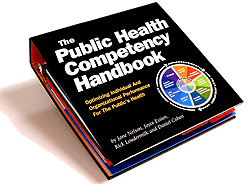 |
|
Improving performances
Jane Nelson, emeritus professor and former associate director of the Center for Public Health Practice, is the
first author of the Public Health Competency Handbook.
Joyce Essien, director of the center, is a co-author. The
book has been distributed to state and local health departments nationwide, and it aims to help public health
departments establish consistent and high standards of organizational performance.
|
On call for the community
|
A winter storm approached ominously the evening of January 2, 2002, and by dawn, metro Atlanta was blanketed in
4.6 inches of snow. At Hartsfield International Airport, thousands of stranded travelers waited as crews de-iced
the planes lined up outside. Hours later, the planes were ready for take-off, but close by and out of sight, a
clogged drainage pipe caused as much as 180,000 gallons of de-icing fluid to bypass the treatment system and
empty into the Flint River, a key source of drinking water for south Fayette County.
More than three months later, Howard Frumkin, chair of the RSPH Department of Environmental and Occupational
Health, addressed concerned citizens at the Peachtree City Library. Pregnant women and nursing mothers who had
been drinking Fayette County water had been calling him at Emory’s Pediatric Environmental Health Specialty Unit,
worried that the de-icing fluid might have harmed their babies. |
|

Pregnant women and nursing mothers in Peachtree City were anxious and
concerned when they realized their drinking water was contaminated with airplane de-icing fluid, which can
lead to birth defects. |
“With a situation like this, there are no easy answers. You can’t say, ‘There’s no danger,’ and you can’t say,
‘You’re certain to have a birth defect,’” Frumkin says. “It’s a question of odds.”
Peachtree City residents like Patty Culjak were frustrated with state and local water departments and
environmental agencies. Three months pregnant at the time of the spill, Culjak had noticed an odd smell to her
drinking water and called the water department and state environmental officials. She had heard nothing about the
spill.
“The water had a stench,” she says. “Some people described it as syrup smell, but my immediate thought was
antifreeze.”
Finally, at the end of January, the Flint River was tested and found contaminated with traces of the de-icing
chemicals propylene glycol and ethylene glycol, which can cause birth defects. Frumkin suggested careful
diagnostic testing for infants before and after birth.
“Universities should provide public health information to the community, especially when there’s a level of
anxiety and a legitimate basis for concern,” Frumkin says. “It’s an important part of our school’s mission to
provide service to the community when we can.”
Childhood pneumococcal vaccine saves lives
A new version of a pneumococcal vaccine reduced the incidence of pneumonia in 40,000 children in a clinical trial
in Soweto, South Africa, by more than 20%, concluded researchers from the Rollins School of Public Health (RSPH)
and the University of Witwatersrand in South Africa.
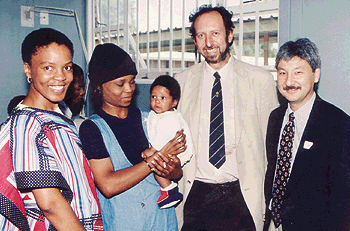
Keith Klugman (second from right) with the first child
included in his clinical trial of a new pneumococcal vaccine. |
|
The vaccine reduced the incidence of invasive disease—pneumococcal bacteria in the bloodstream—by
more than 80% in children not infected with HIV and by more than 50% in HIV-infected children.
Keith P. Klugman, professor of International Health at RSPH, was principal investigator of the study. The World
Health Organization, the Medical Research Council of South Africa, and Wyeth Pharmaceuticals, which developed the
vaccine, were collaborators. |
Pneumonia is the leading cause of death in children worldwide and is responsible for approximately 4 million
deaths a year, mostly in developing countries. Although pneumonia has many different causes, the pneumococcal
bacterium is the primary source. Until recently, no vaccine was available to prevent pneumococcal disease in
young children.
“With this reduction in the incidence of pneumonia, we could potentially save more than 500,000 lives each year
in the developing world,” says Klugman. “In addition, no vaccine has previously been documented to prevent
pneumococcal disease in HIV-infected children, and our study showed a 50% reduction in this group. In an era in
which there is little to offer children with HIV, we can clearly reduce invasive disease.”
| Huda C. Zurayk,
dean of Health Sciences faculty at the American University of Beirut, gave the Virginia S. DeHaan
Lecture on Health Promotion and Education this past spring. In her lecture, “Going Beyond: An Experience With
Boundaries,” she discussed the difficulties of ensuring the public health in a society like Lebanon that has
struggled with conflict antagonized by boundaries that divide religious factions, ethnic groups, and the sexes.
“Education is the answer,” she said. |
|
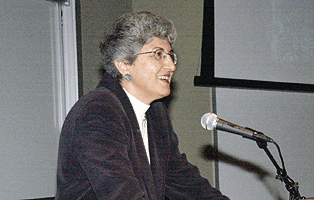 |
Preparing for public health emergencies
Best-selling science writer Richard Preston, author of The Hot Zone, held an Emory crowd spellbound this
past October as he described his many years of research on man’s tumultuous relationship with smallpox. His
newest book, The Demon in the Freezer, is a gripping account of emerging bioterrorist threats, the
smallpox eradication
program, and the biowarfare programs of the United States and the former Soviet Union.
 |
|
Preston spoke as part of the Triangle Club lecture series, sponsored by the Center for Public Health Preparedness
and Research at the Rollins School of Public Health. This monthly event brings together Atlanta professionals in
public health, health care, and academia who are working on issues related to bioterrorism preparedness. Sam
Nunn, former US senator and co-chair of the Nunn-Turner Nuclear Threat Initiative, gave the first Triangle Club
lecture this past September. |
Since forming just nine months ago, the center has forged new partnerships with government and academic experts
in bioterrorism and established new programs to prepare students and public health professionals for this new
emphasis in public health. Some noteworthy accomplishments include the following:
- Establishment of a Centers for Disease Control and Prevention (CDC)-sponsored public health preparedness
program to focus on training public health professionals throughout Georgia about bioterrorism preparedness.
Associate Dean for Applied Public Health Kathleen Miner is principal investigator.
- A new course called Public Health Preparedness and Bioterrorism. Ruth Berkelman, the Rollins Professor of
Public Health Preparedness and director of the center, and Philip Brachman, anthrax expert and Professor of
International Health, are co-directing the course.
- A new course called Crisis Communications and Public Health, developed and taught by Melissa Shepherd, a
visiting communications associate from the CDC.
- Ongoing research involving the development and evaluation of early-detection systems for epidemics and
changes in health care utilization after a terrorist event.
- A Student Outbreak Response Team, formed in collaboration with the DeKalb County Board of Health. This
voluntary group allows students to gain experience working in a local public health department. The students are
also on call to help the country during emergency situations.
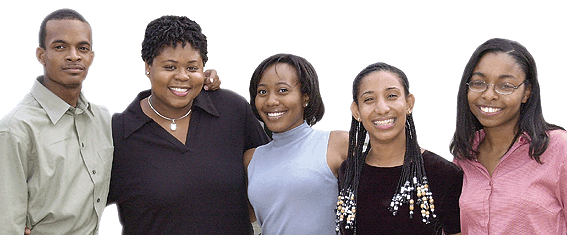
Anita Washington, second from left, is president of the newly formed Association
of Black Public Health Students. The group strives to support students and raise
awareness of health issues among African-Americans. |
Paying the price of smoking
An Internet-based version of a health economics software program developed by researchers at the Rollins School
of Public Health (RSPH) and the Centers for Disease Control and Prevention (CDC) allows users to calculate the
direct and indirect costs of cigarette smoking for adults and newborn children within and across states.
By first estimating the number of smoking-related deaths in the current year, the software can
estimate the economic costs associated with the years of productive life lost for adults. It also estimates
annual medical expenses for smoking-related conditions for adults and infants.
|
The original software program, called the Smoking-Attributable Mortality, Morbidity, and Economic Costs (SAMMEC),
has been used extensively for many years. This new release is the first web-based version and the first to
include a maternal and child health component. This aspect of the program allows users to estimate the number of
infant deaths associated with maternal smoking, years of potential life lost for these infants, and neonatal
medical expenditures linked to active maternal smoking. Smoking while pregnant has been associated with reduced
birth weight, sudden infant death syndrome, and respiratory conditions in infants. |
|
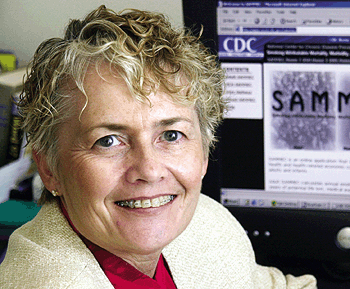 |
Health economist Kathleen Adams, RSPH professor of Health Policy and Management,
worked closely with the Division of Reproductive Health and the Office of Smoking and Health at the CDC on the
project. The maternal and child health component of SAMMEC currently estimates only smoking-attributable
expenditures related to neonatal medical conditions. Adams hopes to add the
capacity to calculate smoking-related costs into an infant’s first year of life and early childhood, including
effects of maternal smoking before birth and second-hand smoke exposure after birth.
Data produced by SAMMEC should encourage Medicaid program managers to reimburse providers for smoking-cessation
programs since many of their enrollees are pregnant women and infants. These statistics can also help managed
care organizations manage the health status and projected costs of their enrollees. Economists and others
interested in the impact that smoking has on the economy should also find it useful. Users can access the SAMMEC
software at: www.cdc.gov/tobacco/SAMMEC
Intensive care
Emory researchers have found that nearly 9% of insured women are hospitalized during their pregnancies, with the
majority of hospitalizations among younger women, women with multiple gestations, and women in the northeastern
United States. The findings were published in the July 1 issue of Obstetrics and Gynecology.
Researchers at the Emory Center on Health Outcomes and Quality analyzed data from Aetna, Inc. the largest managed
care organization in the United States, using information gathered from 46,179 pregnant women who had a live
birth or pregnancy loss. Overall, 8.7 % of these women were hospitalized during pregnancy. The primary causes for
hospitalization were hypertension, nausea, premature rupture of membranes, and pre-term labor. Costs for these
hospitalizations topped $36 million.
 |
|
Julie Gazmararian,
a professor in the Department of Health Policy and Management at the Rollins School of Public Health (RSPH) and
lead investigator for the study, suggested several ways to reduce pregnancy-related
hospitalizations. “Certain conditions, such as hypertension, may be treated more effectively in an outpatient
setting,” she says. "If high-risk patients are better educated on warning signs and certain conditions,
hospitalization might be prevented."
Further study may identify specific reasons for these hospitalizations, determine whether they can be prevented,
and hopefully lower maternal and fetal illness, Gazmararian concluded. |
The study is the first to use data from a large national managed care population to monitor inpatient care
received by women during pregnancy. Consequently, the study does not include uninsured and other vulnerable
populations. The Emory Center on Health Outcomes and Quality—a multi-school, multi-
disciplinary group within The Robert W. Woodruff Health Sciences Center at Emory—conducts research aimed at
improving quality-of-care measurements and designing interventions to improve health outcomes. It works with
consumers, physicians, and insurers to evaluate and implement new approaches for improving quality of care.
Cyber text
Epidemiologist David Kleinbaum has harnessed the latest
cutting-edge technology to develop a revolutionary new teaching tool called ActivEpi,
an interactive electronic textbook on the
fundamentals of epidemiology. This book on CD-ROM uses innovative learning tools such as video clips, animation,
narration, interactive exercises, Internet links, and a point-and-click glossary, index, and appendices. Built-in
software also allows students to practice analyzing data sets.
During his many years as an award- winning professor at the Rollins School of Public Health (RSPH), Kleinbaum has
always sought the best new ways to reach students. He is internationally known as the author of some of the most
widely used textbooks on epidemiology and biostatistics.
With the help of Data Description Inc., an educational multimedia development firm, Kleinbaum developed this
electronic textbook to bring epidemiology to a wider range of students.
“ActivEpi is appropriate for people at all levels of experience,”
he says. “Public health and medical students, public health professionals, and medical researchers all can
benefit from the interactive methods ActivEpi uses to teach epidemiologic concepts.”
The ActivEpi CD-ROM and its companion hard-copy text can be used in on-campus courses, distance learning
programs, or for self-paced learning. It could be particularly useful for public health professionals in the
developing world.
Several RSPH professors plan to incorporate ActivEpi and its companion text into their classes. The
Centers for Disease Control and Prevention, which helped fund the development of ActivEpi, will use it to help
train public health professionals in the Unites States and abroad.
The ActivEpi CD and the ActivEpi companion text are now available for purchase from
Springer-Verlag.
http://www.sph.emory.edu/~dkleinb/activepi.htm
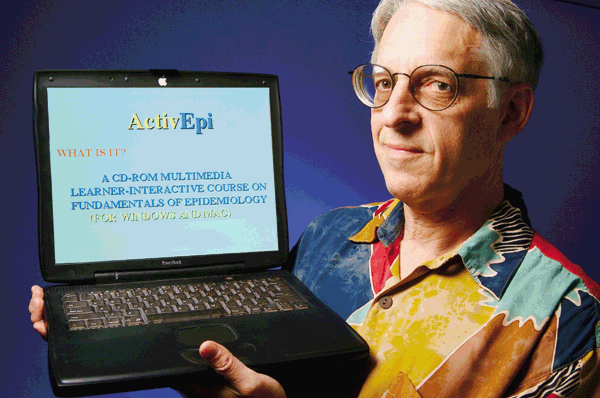
David Kleinbaum has developed the first CD-ROM epidemiology textbook ever. It
features interactive graphics and illustrations of the basic principles of epidemiology. |
|













